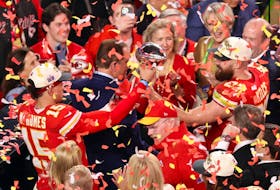The flag that has become the symbol of this country made its first public appearance on Feb. 15, 1965.
I can’t swear that was the day Little Mountain Elementary in Chilliwack gathered for its unveiling. But I do remember the feelings the assembly created in my nine-year-old self. The flag was new and that was exciting. But it was also vaguely unsettling because it was something different, something unfamiliar.
I knew the Red Ensign. It had flown at every school I attended. In Regina we lived on the RCMP base and every night there was a solemn ceremony in which the flag was lowered while a bugler played.
This new flag, however, didn’t seem as serious. The red Maple Leaf in its centre was plain and simple, nothing like the more detailed Maple Leaf worn by the Toronto hockey club that appeared on our television screen most Saturday nights.
The symbolism of the red bars was also lost on me. I was told it represented the two coasts of Canada but, honestly, I couldn’t see it.
This was going to take some getting used to.
That was 55 years ago. Now it’s become a part of us. I know it’s just a symbol and there’s a piece of me who wishes there weren’t flags. But it means something to this country, something we hope reflects the best in ourselves. The red Maple Leaf in the centre isn’t plain and simple. It’s strong and resolute. It’s framed by the two red bars, the east and west coasts of this beautiful, sprawling country.
Over the years, this job has taken me to places where our flag has been displayed, where it’s been worn by this country’s young people in athletic competition, and if there’s a higher purpose to the Maple Leaf I’ve yet to see it.
The first Olympics I covered were in Sydney in 2000 and the Games weren’t kind to Canada. Simon Whitfield won gold in the men’s triathlon. Daniel Nestor and Sebastien Lareau won gold in men’s tennis. Beyond that there wasn’t much to cheer about until the final day of competition when Daniel Igali, a political refugee from Nigeria who settled in Surrey, won gold in men’s freestyle wrestling.
After defeating Russian Arsen Gitanov, Igali was passed a Canadian flag that he wore like a superhero wears a cape. He placed the flag on the wrestling mat, ran around it twice, then bent down and kissed it.
When they placed the gold medal around his neck and played O Canada, he cried. Afterwards he said he ran around the flag to show the complete cycle of his life.
“Six years ago (I came to Canada), and I’ve realized all my dreams,” he said.
Similar scenes have played out at the Olympics over the years. In 2008 the men’s eight won gold in Beijing after they’d finished a disappointing fifth in Athens four years before. Five members of the Athens boat won gold in China, including Adam Kreek.
The crew assembled on the dock for the medal presentation, gigantic men in spandex with the Maple Leaf on their chests. When they played O Canada, Kreek sang in a voice that echoed around the lake.
I became friendly with members of that crew. I asked one of them how much they’d earned in their gold-medal year. He said $60,000.
Flash forward to 2016 and the Summer Games in Rio, where the women’s rugby sevens won bronze. It was the first year for the sport on the Olympic calendar and these women regarded themselves as trailblazers for the new sport. They were also a splendid representation of this country: Young and old, black and white, francophone and anglo, gay and straight, all working towards a common purpose.
On their jerseys they wore the Maple Leaf over their heart. When they won their medal they laughed and cried, sang O Canada, then drank beer together, a team this night and always.
“I’ve known some of these girls since I was 15 years old,” said team captain Jen Kish. “To build a dream together and complete a dream together, there’s no words for it.”
The stories don’t always end happily. Mellisa Hollingsworth came into the Vancouver Winter Olympics as a medal favourite in women’s skeleton, sat in second heading into the final run but ultimately finished fifth after a brutal final turn.
“I feel like I’ve let my entire country down,” she said through tears.
Two years before I’d been in Ghana with Hollingsworth and fellow Winter Olympians Emily Brydon, Steve Omischl and Clara Hughes as part of a Right To Play mission. If you would have seen her there, seen how she and the others interacted with kids on the other side of the world, the idea of her disappointing anyone in Canada was absurd.
Still, the Maple Leaf can be a burden. In Turin in 2006 I ran into a sombre Pat Quinn, walking the streets alone after Canada’s seventh-place finish in the men’s hockey tournament. He wasn’t exactly chatty, but he did perk up when I told him I’d been covering speed skating, where Winnipeg’s Cindy Klassen had won five medals.
“I saw that,” he said. “That was quite a performance.”
Four years before in Salt Lake, Quinn coached a men’s team that won gold, breaking a 50-year Olympic drought for Canada. At both Olympics he wore the Maple Leaf, wore it proudly, wore it knowing it connected him to every person in this country.
After all these years it still does.
CLICK HERE to report a typo.
Is there more to this story? We’d like to hear from you about this or any other stories you think we should know about. Email [email protected] .
Copyright Postmedia Network Inc., 2020








